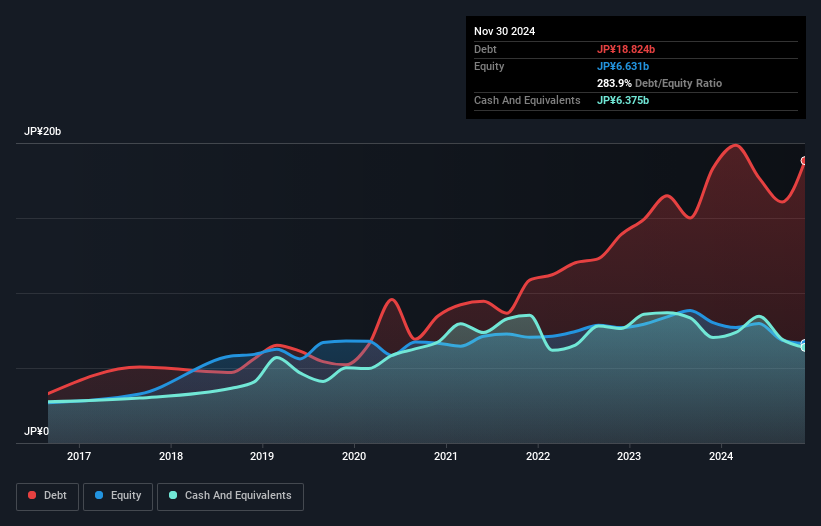
Legendary fund manager Li Lu (who Charlie Munger backed) once said, 'The biggest investment risk is not the volatility of prices, but whether you will suffer a permanent loss of capital.' It's only natural to consider a company's balance sheet when you examine how risky it is, since debt is often involved when a business collapses. Importantly, Valuence Holdings Inc. (TSE:9270) does carry debt. But the real question is whether this debt is making the company risky.
When Is Debt Dangerous?
Debt is a tool to help businesses grow, but if a business is incapable of paying off its lenders, then it exists at their mercy. Part and parcel of capitalism is the process of 'creative destruction' where failed businesses are mercilessly liquidated by their bankers. However, a more common (but still painful) scenario is that it has to raise new equity capital at a low price, thus permanently diluting shareholders. By replacing dilution, though, debt can be an extremely good tool for businesses that need capital to invest in growth at high rates of return. When we examine debt levels, we first consider both cash and debt levels, together.
What Is Valuence Holdings's Debt?
The chart below, which you can click on for greater detail, shows that Valuence Holdings had JP¥18.8b in debt in November 2024; about the same as the year before. On the flip side, it has JP¥6.38b in cash leading to net debt of about JP¥12.4b.

A Look At Valuence Holdings' Liabilities
Zooming in on the latest balance sheet data, we can see that Valuence Holdings had liabilities of JP¥13.3b due within 12 months and liabilities of JP¥9.42b due beyond that. Offsetting these obligations, it had cash of JP¥6.38b as well as receivables valued at JP¥3.00b due within 12 months. So its liabilities total JP¥13.4b more than the combination of its cash and short-term receivables.
Given this deficit is actually higher than the company's market capitalization of JP¥9.97b, we think shareholders really should watch Valuence Holdings's debt levels, like a parent watching their child ride a bike for the first time. Hypothetically, extremely heavy dilution would be required if the company were forced to pay down its liabilities by raising capital at the current share price. There's no doubt that we learn most about debt from the balance sheet. But it is future earnings, more than anything, that will determine Valuence Holdings's ability to maintain a healthy balance sheet going forward. So if you want to see what the professionals think, you might find this free report on analyst profit forecasts to be interesting.
View our latest analysis for Valuence Holdings
In the last year Valuence Holdings wasn't profitable at an EBIT level, but managed to grow its revenue by 2.6%, to JP¥81b. That rate of growth is a bit slow for our taste, but it takes all types to make a world.
Caveat Emptor
Over the last twelve months Valuence Holdings produced an earnings before interest and tax (EBIT) loss. Indeed, it lost JP¥141m at the EBIT level. Considering that alongside the liabilities mentioned above make us nervous about the company. We'd want to see some strong near-term improvements before getting too interested in the stock. Not least because it had negative free cash flow of JP¥1.4b over the last twelve months. That means it's on the risky side of things. When analysing debt levels, the balance sheet is the obvious place to start. However, not all investment risk resides within the balance sheet - far from it. These risks can be hard to spot. Every company has them, and we've spotted 2 warning signs for Valuence Holdings (of which 1 can't be ignored!) you should know about.
If, after all that, you're more interested in a fast growing company with a rock-solid balance sheet, then check out our list of net cash growth stocks without delay.
New: Manage All Your Stock Portfolios in One Place
We've created the ultimate portfolio companion for stock investors, and it's free.
• Connect an unlimited number of Portfolios and see your total in one currency
• Be alerted to new Warning Signs or Risks via email or mobile
• Track the Fair Value of your stocks
Have feedback on this article? Concerned about the content? Get in touch with us directly. Alternatively, email editorial-team (at) simplywallst.com.
This article by Simply Wall St is general in nature. We provide commentary based on historical data and analyst forecasts only using an unbiased methodology and our articles are not intended to be financial advice. It does not constitute a recommendation to buy or sell any stock, and does not take account of your objectives, or your financial situation. We aim to bring you long-term focused analysis driven by fundamental data. Note that our analysis may not factor in the latest price-sensitive company announcements or qualitative material. Simply Wall St has no position in any stocks mentioned.
About TSE:9270
Valuence Holdings
Engages in the purchase, auction, and sale of reused goods in Japan and internationally.
Good value with reasonable growth potential.
Market Insights
Community Narratives



